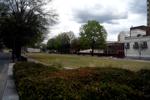5th Street Bridge expected to open late May | News
From the marina below, they look like pennants, little clusters of three or five dun-colored flags.
What they are is an answer to the hot-hot-hot Georgia and South Carolina summer, meant to filter the sun’s rays and temper its heat in pockets along the 1,202 feet of concrete that has, over the past two years, been evolving from vehicle conduit to pedestrian esplanade.

The 5th Street bridge linking downtown Augusta with North Augusta is expected to open at the end of the month. Those pennant-like shade structures are one of the most recent additions to the bridge.
The $11.05 million project has experienced supply-chain issues throughout its construction, which began early during the COVID-19 pandemic, in June of 2020. But now, only the at-deck items like benches plus a bit more painting is left to complete, said Hameed Malik, director of engineering for the city of Augusta.
“We feel like it’s a very important project because it will hopefully bring some redevelopment to that end of Broad Street,” said Margaret Woodard, executive director of DDA Augusta.

Augusta Metro Chamber of Commerce and the Downtown Development Authority of Augusta are hopeful that reworking the 5th Street Bridge as a pedestrian concourse will help to bring economic development to lower Broad Street. As it stands, most of the activity on Broad is between 7th and 13th streets.
Both the Downtown Development Authority of Augusta and the Augusta Metro Chamber of Commerce have been involved in the project with the hope that its redesign will spur further economic development in that sparse area of lower Broad in downtown Augusta.
The idea when planning began in 2017 was to turn the 5th Street Bridge into a destination, said Woodard, something akin to the Augusta Riverwalk whose lower path runs up to meet the bridge. “This would be something for residents and visitors to come down and explore.”
There’s been talk of a zipline and food trucks and cornhole. The extra features are still only conceptual, but there is money in the budget for them with $1.75 million set aside through SPLOST (Special Purpose Local Option Sales Tax, approved by voters last March), and Woodard said she’s happy with how things are shaping up so far.
“We didn’t want it to be necessarily just a bridge that you walk across,” she added. “We wanted it to be a bridge that offered amenities that were family-friendly.”
Woodard said, too, that from a redevelopment standpoint she is hopeful the pedestrian bridge will help attract more business on lower Broad Street. “It’s certainly an economic development tool.”

Across the Savannah River, in North Augusta, the city has been taking a wait-and-see approach on how to invest in that area where the bridge currently links only with open land and, a little farther on, with small residential neighborhoods.
Jim Clifford, city administrator for North Augusta, said that the city was open to partnering with its Georgia neighbor, but that he and other North Augusta officials wanted to see more fidelity in the plans and a more concrete direction for what, specifically, was to happen with the bridge.
Design of the pedestrian bridge had begun in 2017 after the city of Augusta had determined the repairs necessary for bringing the deteriorating brick-and-steel bridge back up to standard for vehicle traffic were beyond budget. Augusta’s Malik previously had earlier told Post and Courier North Augusta that the estimate was $16 million.







